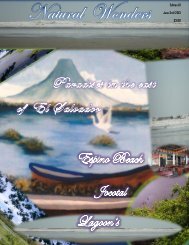p17sd0e9b51pna1s4msha9vp10p54.pdf
Create successful ePaper yourself
Turn your PDF publications into a flip-book with our unique Google optimized e-Paper software.
Do you know<br />
that….?<br />
Edited by:<br />
Karen<br />
Vanessa<br />
Ascencio<br />
On February 2, 2010 by the Ramsar<br />
Convention, The Laguna de Olomega<br />
was declared Wetland of<br />
International Importance it’s a really<br />
beautiful place that you can enjoy<br />
whit family and friends.<br />
A body of water which is composed<br />
by The core of the wetland of variable<br />
surface with an average depth of 2.9<br />
meters and also inside which are the<br />
islands of Olomeguita and Olomega,<br />
along with some small islets located in<br />
the southeast sector of the lagoon.<br />
The dominant species of the water<br />
surface area is the Water Hyacinth.<br />
Besides this there are other species of<br />
aquatic plants associated with the<br />
lagoon and herbaceous wetland areas<br />
such as the tule<br />
sequins, water lettuce.<br />
In the seasonally saturated forest<br />
The forest stands to contain<br />
Chiricana with Lempita marsh,<br />
mangrove best spots (Bravaisia<br />
integerrima) of fresh water in the<br />
country<br />
Area dominated by tree species that<br />
support<br />
periodic<br />
flooding, as in<br />
the case of<br />
gender Bactris<br />
palms,<br />
mangrove and<br />
less sweet<br />
pepper. Other species include<br />
Papaturro, the carreto and<br />
mongollano.<br />
The fish fauna (fish) is quite diverse<br />
with 14 species identified for the area,<br />
among which black crappie, guapote<br />
pando, and exotic species such as<br />
tilapia and tiger guapote. The area is<br />
especially important as a feeding,<br />
shelter, breeding or resting<br />
waterfowl.<br />
5





